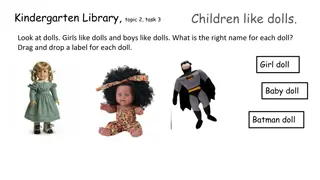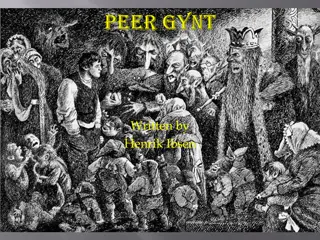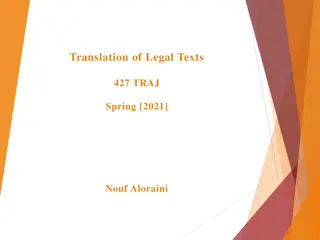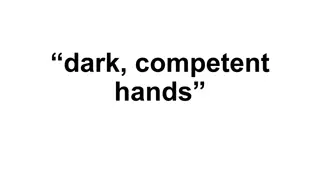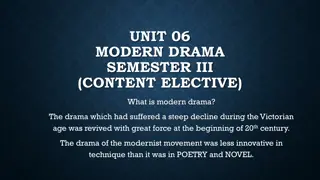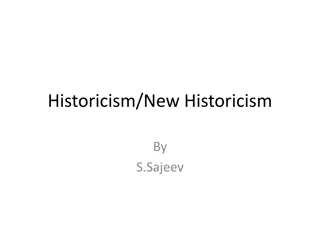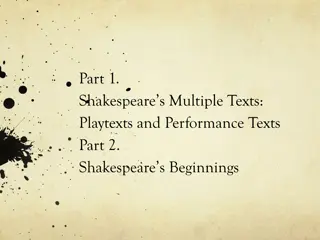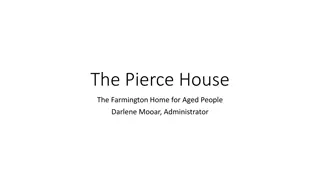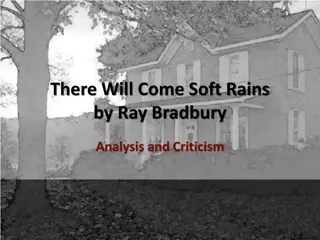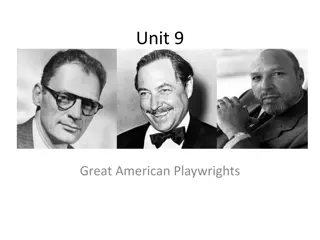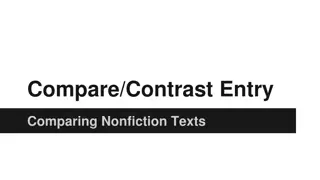Exploring Themes in Henrik Ibsen's "A Doll's House" and Related Texts
The content delves into various themes from Henrik Ibsen's play "A Doll's House," along with related discussions on patriarchy, matriarchy, bourgeois audiences, and the essence of plays as unique worlds. Through analyses of space, time, character dynamics, and societal constructs, the exploration offers deeper insights into the complexities portrayed in the play and its context within the realm of literature and theater.
Download Presentation

Please find below an Image/Link to download the presentation.
The content on the website is provided AS IS for your information and personal use only. It may not be sold, licensed, or shared on other websites without obtaining consent from the author. Download presentation by click this link. If you encounter any issues during the download, it is possible that the publisher has removed the file from their server.
E N D
Presentation Transcript
Henrik Ibsen, A Doll s House (1879) ELIZABETH BARRY
Kate Millett, Sexual Politics (1970), p. 115 In Aeschylus dramatization of the [Orestes] myth, one is permitted to see patriarchy confront matriarchy, confound it through the knowledge of paternity, and come off triumphant. Until Nora slammed the door announcing the sexual revolution, this triumph went nearly uncontested.
Herbert Blau, The Dubious Spectacle: Extremities of Theater, 1976-2000 The bourgeois audience that, according to now standard analysis, was ready to support a theatre reproducing its own image, even when that image, as in Ibsen or Strindberg or Pirandello, was next to appalling and in no way edifying at all. (11)
Some Questions to Ask a Play (after Elinor Fuchs) I. The World of the Play: First Things First A play is not a flat work of literature, not a description in poetry of another world, but is in itself another world passing before you in time and space. Language is only one part of this world. Those who think too exclusively in terms of language find it hard to read plays. When you "see" this other world, when you experience its space-time dynamics, its architectonics, then you can figure out the role of language in it. (Fuchs, EF s Visit to a Small Planet: Some Questions to Ask a Play , Theater, 34: 2 (2004), 4-9)
What is space like in this world? Interior or exterior? Built or natural? Confined or open wide? Act I: SCENE.--A room furnished comfortably and tastefully, but not extravagantly. [ ] a stove, two easy chairs and a rocking-chair; between the stove and the door, a small table. Engravings on the walls; a cabinet with china and other small objects; a small book- case with well-bound books. The floors are carpeted, and a fire burns in the stove. It is winter. A bell rings in the hall; shortly afterwards the door is heard to open. Enter NORA, humming a tune and in high spirits. She is in outdoor dress and carries a number of parcels [ ] She leaves the outer door open after her, and through it is seen a PORTER who is carrying a Christmas Tree and a basket, which he gives to the MAID who has opened the door. [Hidden spaces?]
How does time behave in this world? What is the rhythm of Nora s day? How far does it differ from Torvald s? Does it change over the course of the play? What kind of relationships do the characters have to past and future? The time frame that opens up at the beginning of the play: Helmer: There can be no freedom or beauty about a home life that depends on borrowing and debt. We two have kept bravely on the straight road so far, and we will go on the same way for the short time longer that there need be any struggle. How Nora sees the future Mrs Linde. Do you mean never to tell him about it? Nora [meditatively, and with a half smile]: Yes--someday, perhaps, after many years, when I am no longer as nice-looking as I am now. Don't laugh at me! I mean, of course, when Torvald is no longer as devoted to me as he is now; when my dancing and dressing-up and reciting have palled on him; then it may be a good thing to have something in reserve--[Breaking off.] What nonsense! That time will never come.
II. The Social World of the Play. A Closer Look. Public or private world? Christiania is present-day Oslo, but at this point a provincial capital of a marginalized region of Sweden. [Before Norwegian independence.]* Late C19. Beginnings of industrialization and nationalism (but also mass emigration away to the USA). Cut off from European culture. Everyone from governing and professional classes knew each other. Family and duty to family paramount. Men unlimited power over their wives. Lutheran world so people judged not by family background, but actions and deeds. So you could make it to the top by hard work, but a mistake could cast you out forever. Class rules? Social status? Economic status? * See Stephen Unwin (director), Ibsen , The London Magazine, Oct 10, 2013 https://www.thelondonmagazine.org/ibsen-by-stephen-unwin/
Women in this social world? Not allowed the vote, or to carry out most financial transactions. Expected to marry, expected to bear children, expected to obey the rule of the husband. Ibsen s speech in support of the appointment of a female librarian at the Scandinavian Circle in Rome (1879 writing play): Is there anyone in this assembly who dares to claim that our women are inferior to us in culture, intelligence, knowledge or artistic talent? I don t think many men would dare to suggest that. Then what is it men are afraid of? [ ] What I am afraid of is men with small ambitions and thoughts, small scruples and small fears, those men who devote all their ideas and all their energies to obtain certain small advantages for their own small and servile selves.
Ibsen, Notes for a Tragedy of Modern Times The wife in the play ends by having no idea what is right and what is wrong; natural feeling on the one side, and belif in authority on the other lead her to utter distraction. A woman cannot be herself in modern society. It is an exclusively masculine society, with laws made by men, and with prosecutors and judges who judge feminine conduct from the masculine standpoint. She has committed forgery, and it is her pride; for she did it for love of her husband and to save his life. But this husband, full of everyday rectitude, stands on the basis of the law and regards the matter with a masculine eye. (Quoted in Stephen Unwin, Ibsen s A Doll s House, 16)
Fuchs, Some Questions to Ask A Play We must make the assumption that in the world of the play there are no accidents. Nothing occurs by chance, not even chance. In that case, nothing in the play is without significance. Correspondingly, the play asks us to focus upon it a total awareness, to bring our attention and curiosity without the censorship of selective interpretation [ ] (6; my emphasis) CF. Chekhov s gun One must never place a loaded rifle on the stage if it isn't going to go off. It's wrong to make promises you don't mean to keep." Chekhov, letter to Aleksandr Semenovich Lazarev (pseudonym of A. S. Gruzinsky), 1 November 1889.
Fuchs: How do people dress? [1973 film, dir. Patrick Garland] https://www.youtube.com/watch?v=TMa0ZARfZBM Helmer learns he is spared (by the second letter of Krogstad s) emollient speech about forgiveness. Idealism reinstated. Nora comes back in in everyday clothes. Helmer still in his formal finery. One of them = under/overdressed. Hugely significant detail. 2004 Gothenburg production Norwegian dir. Terje Maerli production short -- busy middle-class family, phones, laptops Nora in red miniskirt then dressed appropriately at end to go out into Scandiavian winter (boots and warm coat, ready to take on world).
Social World (Fuchs, cont.) Patterns do you see people in groups? Isolated? In pairs? Pairs: relationship Nora Linde. Linde Krogstad. Nora Helmer. Allegiances or conflicts? Allegiances that conflict? Talking about a third person. ADH: threes. Helmer, Nora, Rank. Nora, Helmer, Krogstad. Nora, Krogstad, Linde. But -- Tiina Rosenberg: Unique thing about Doll s House that it is about a husband-wife relationship without also being about a love triangle. Women s role at centre of play/ discussion. The tension of interlocking triangles? How do people interact? Do they shout? Do they laugh? Do they play? Mode of interacting important in this play. Playing. Serious conversation. Krogstad arguably the only person who treats Nora as an equal.
III. What changes? First image. Last. Some striking image in middle. What has changed? How do we need to pass through the middle image to get from first to last? Table: Beginning Act I: Putting parcels on it. way through Act I: Hiding under the table hide and seek with the children (but they can hear her laughter, find her). Just before she talks to Krogstad and he threatens her. End of Act II: Nora on top of the table, dancing the tarantella to shocked (and aroused?) Helmer. Act III: Nora sitting across the table, wanting to talk.
VI. The Character Fits the Pattern Only now, for Fuchs, are you ready to analyse the characters. Every assumption you make about the character must reflect the conditions of its world. Characters identity fixed or changing? Nora changes character? Krogstad not villain (desperate, angry, bitter). Rank funny kind of lothario How far character emerges in relation to circumstances.
Noras tarantella scene Nora is dancing the tarantella in Act II, fast and wildly. How deliberate/ strategic is this? A) to distract Helmer from the mailbox and the letter that might be her undoing. B) To postpone her own inevitable death (she has determined (and told Krogstad) that she will commit suicide when Helmer learns the truth) C) without premeditation, or at least becoming less conscious of what she is doing -- as a hysterical expression of her inner turmoil. (Freudian interpretation) D) An erotic performance at odds with her image as pure, submissive wife -- exposing men s hypocrisy asks Mrs Linde to watch the fun (watch men watching as well as her dancing)
Toril Moi, Henrik Ibsen and the Birth of Modernism The scene [of the tarantella] invites the audience to see Nora both as she is seen by Helmer and Dr Rank, and as she is seen by Mrs Linde. Former: theatricalizes her. Latter: sees a soul in pain. Can we, should we, choose between these perspectives? Ibsen s double perspective, his awareness of the impossibility of either choosing or not choosing between theatricality and authenticity, stands at the center of Ibsen s modernism.
Modernity of Ibsens play Unni Langas, What Did Nora Do: Thinking Gender with A Doll s House , Ibsen Studies, vol. 5 (2005) nature to culture being to acting how gender operates on the level of spoken and performed acts.
Fuchs IV. Don t forget yourself. V. Theatrical Mirrors -- other plays. Elfrede Jelinek, What Happened After Nora Left Her Husband (1979) Playing a sequence of roles -- male projections/phantasms of women in the role of a wife, mother, labourer, artist, lover, prostitute, concubine, dominatrix and ultimately a business woman. Scenes: C19 and 1970s. Fassbinder film, Nora Helmer (1974) she stays careerist seizes power in it. Lukas Hnath, Doll s House Part 2 (2017): she has come back, 15 yrs later (play starts with a knock on the door) a successful feminist novelist; comes back for a divorce. Recriminations from the family.
Adaptations: Mabou Mines Dollhouse (2003) male characters played by people of restricted growth. Mark Povinelli (played Helmer): We have all seen Torvald, time and again, and to see one that's so different, even at first look, suddenly opens your eyes Lee Breuer, director: We've really upset men, especially in areas that are tremendously patriarchal, such as South Carolina, where half the upper middle-class couples were like Torvald and Nora. They don't like to be accused of doing what they're doing. I remember one senator who was there saying, 'I'm a liberal, I think there's some good acting. But this play - I'm not that liberal.


